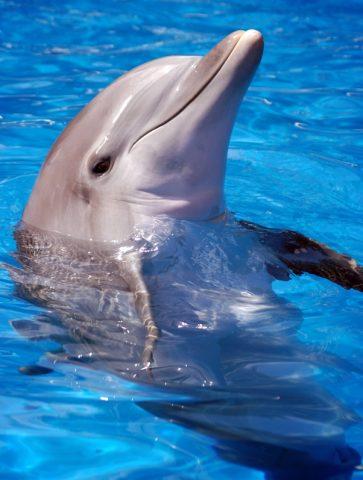
Dolphins Plagued by Similar Diseases as Humans
By Leo Kretzner, 2/18/10,
“Flipper” – that most famous of marine mammals – would quite possibly be one sick dolphin these days. That was a conclusion drawn from presentations by four scientists from separate specialties studying dolphins in their native environment, along coasts and in the open ocean. The talks were a part of the annual meeting of the American Association for the Advancement of Science, currently underway in
Toxic pollution, of both natural and human origin, as well as viral infections and diabetes are some of the ills that the flesh of dolphins is also heir to.
Despite being outlawed in the late 1970’s, PCBs (polychlorinated biphenyls), remain in the environment as so-called “legacy pollutants” – a dubious legacy of the twentieth century. Dr. Lori Schwacke of the Hollings Marine Laboratory in Charleston, SC – part of the National Oceanic and Atmospheric Administration (NOAA) – has documented the highest levels of PCBs ever seen in marine wildlife among dolphins living in estuaries along the coast of Georgia, with concentrations as high as 2900 parts per million.
Using catch-and-release-based medical examinations of dolphins, Dr. Schwacke and her colleagues found signs of altered thyroid hormones, elevated liver enzymes, and suppressed immune function in these animals.
Dr. Schwacke noted, “We can no longer assume or hope that these chemicals over time are completely buried in sediment or washed out to open sea to be diluted – they are clearly still entering the coastal food chain.”
Indeed, the
Humans and dolphins share viruses
Dr. Hendrik Nollens is the lead researcher of the Marine Animal Disease Lab at the
Like humans, dolphins also suffer genital infections of papillomaviruses. However, unlike women with human papilloma viruses (HPV), dolphins have never been found with cervical cancer. Dr. Nollens hopes that sequencing of dolphin viruses’ virulence (disease-causing) genes may yield clues about this difference in outcome to infection.
Dr. Nollens and coworkers have also found that viruses called astroviruses, a cause of gastroenteritis (“stomach flu”) in humans, when isolated from humans and dolphins and grown together, can exchange genetic material with each other.
Similar such “recombination” events are believed to have led to the evolution of human disease viruses such as HIV, SARS, and the
Seafood poisoning and epileptic symptoms in ocean wildlife
Massive blooms of algae, such as the notorious “red tides” occurring at certain times of year, are known to be a source of human poisoning after consumption of contaminated oysters, mussels and clams. The toxin at fault is called domoic acid and is closely related chemically to the human neurotransmitter glutamate. It even binds to the same receptor on the surface of nerve cells – however, it fails to be released by the receptor, leading to what can be called ‘over-signaling’ and sometimes nerve cell death.
Dr. John Ramsdell, a toxicologist at NOAA’s National Centers for Coastal Ocean Science, has helped confirm that various episodes of poisonings accompanied by seizures in pelicans, sea lions and dolphins have all been associated with this toxin. He has also shown that domoic acid can induce seizures acutely and epilepsy after a year’s time in laboratory rats.
Whether domoic acid poisoning can lead to seizure disorders in humans is unknown, but Dr. Ramsdell noted there is at least one medical report of a person who developed temporal lobe epilepsy a year after eating domoic acid-contaminated shell fish. This is a similar time lag between exposure and symptoms as he has found in ocean mammals and lab rodents, suggesting a potential new lead for epilepsy researchers to pursue.
Dolphin diabetics
A welcome piece of potentially positive news was presented by Dr. Stephanie Venn-Watson of the National Marine Mammal Foundation. She and her coworkers have shown that dolphins can go into a natural – and highly adaptive– form of diabetes, with soaring blood sugar levels as muscle cells ignore insulin and fail to take on glucose. This is called ‘insulin resistance’ in human type 2 diabetes, and it’s not a good sign. The dolphins, however, are capable of switching this diabetic state on and off, depending on their feeding status.
Dr. Venn-Watson notes that, like humans, dolphins have very large brains for the size of their bodies – greater even than those of chimps and apes – and these brains depend on sugar for energy. But the dolphin’s diet is very protein-heavy, with sugars in short supply. These animals seem to have undergone natural selection for the ability to become diabetic-like when their brains need sugar.
She said others have suggested that humans may have undergone similar selective pressures during the ice age, when sugary food sources edible by humans were scarce, but animals plentiful. Why humans did not evolve an ability to turn insulin resistance on and off can only be speculated, though the modern over-abundance of carbs in our diets is a hard fact to ignore. In any case, further research on this phenomenon in dolphins – including the sequencing of their genome – may reveal important aspects of blood sugar control in both marine mammals and humans.
Another session on dolphins and other cetaceans (sea mammals) – this one focusing on the ethical implications of their demonstrable intelligence – will be held on Sunday, February 21, here at the AAAS meeting in San Diego, CA, and will be reported here.
~~~~~~~~~~~~~~~~~~~~~~~~~~~~~~~~~~~~~~~~~~~~~~~~~~~
Leo Kretzner is a molecular biologist and science writer living in

Leave Your Comments